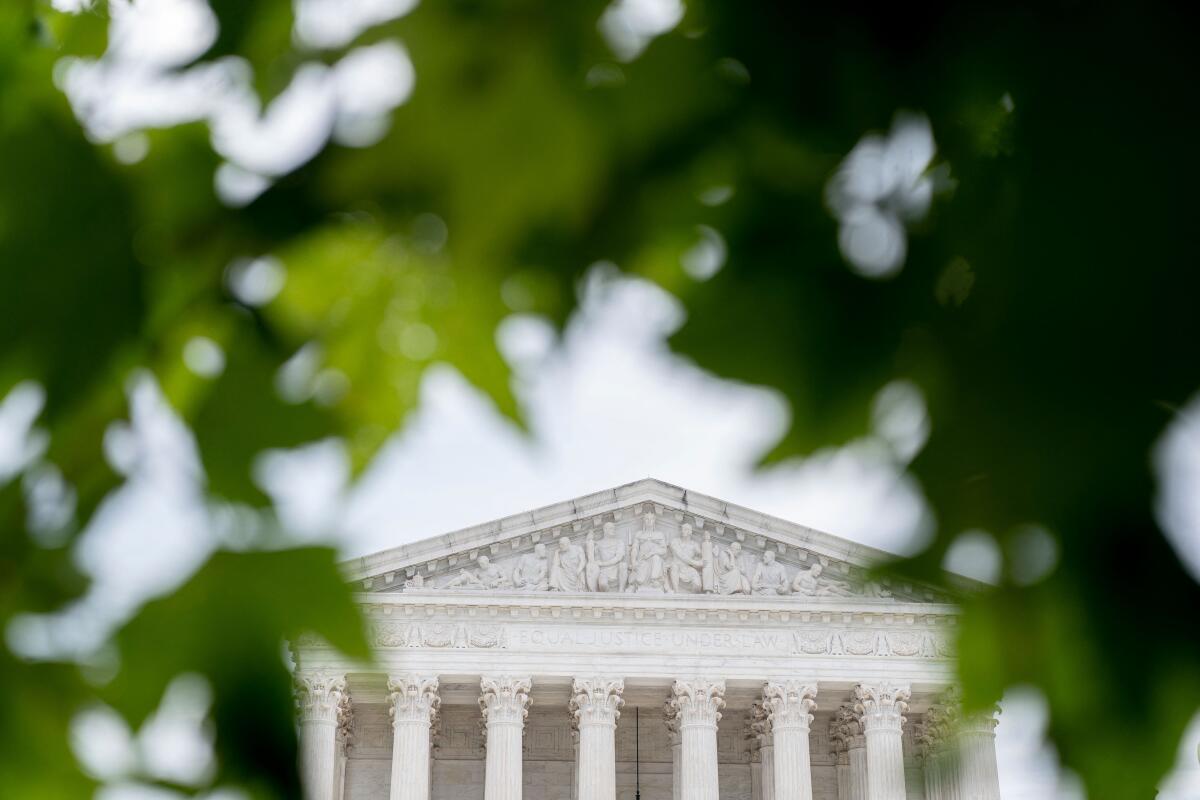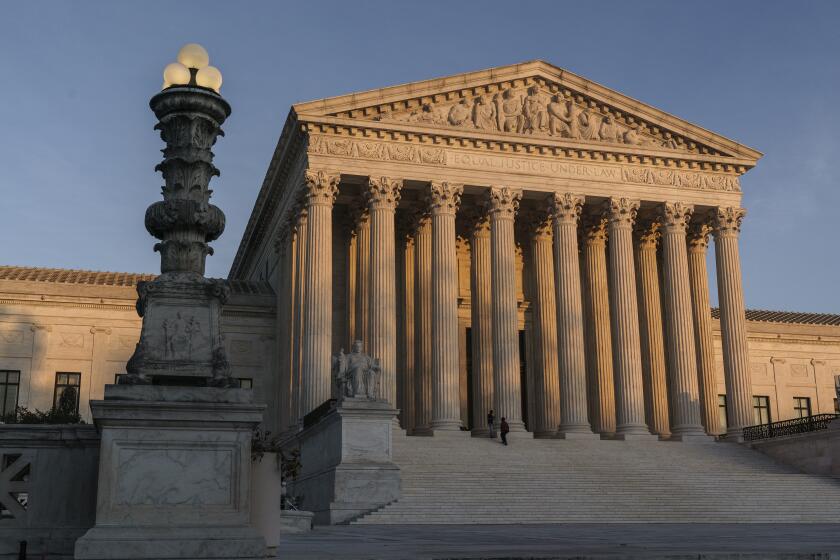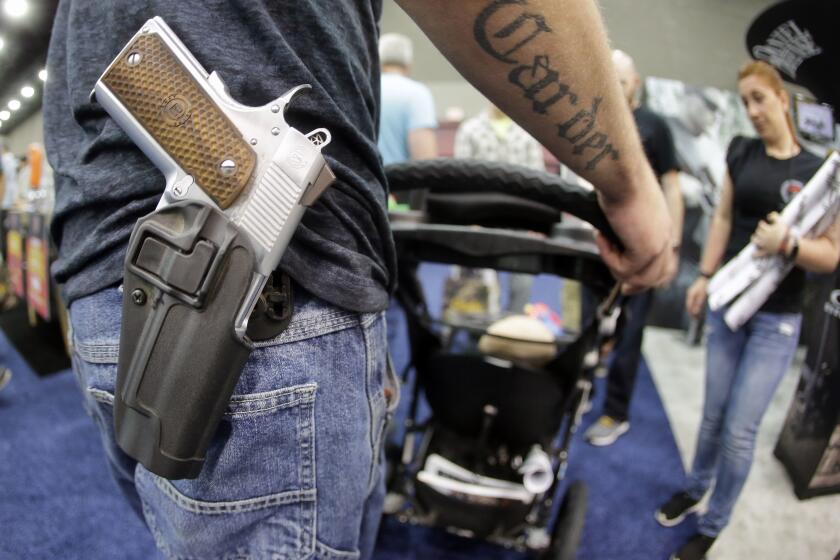Opinion: Supreme Court should protect domestic violence victims from guns, even if the founders didn’t

- Share via
The Supreme Court will hear oral arguments Tuesday in a case that puts the lives of thousands of women in jeopardy. In United States vs. Rahimi, the court will decide the constitutionality of a federal law that prohibits gun possession by people who are subject to domestic violence protective orders.
Every month, 70 women are shot and killed by an intimate partner. An October 2022 report from the Centers for Disease Control and Prevention estimated that more than 12 million adults in the U.S. are victims of domestic violence each year. As the Supreme Court itself has recognized, “the presence of a firearm increases the likelihood that [domestic violence] will escalate to homicide.” An abused woman is five times more likely to be killed by a male partner when there is a firearm in the house. Around one-third of all female homicide victims in the U.S. are killed by an intimate partner.
A new term is beginning with cases on gun rights and administrative agencies already on the docket. Later, the court is likely to decide whether Donald Trump is disqualified from running for president.
States with tighter gun restrictions on people convicted of domestic violence and those subject to restraining orders have been shown to have lower rates of intimate partner homicide. Prohibiting firearm possession by people subject to domestic violence protective orders saves lives. Those lives, however, did not matter to the Court of Appeals for the 5th Circuit, which struck down the federal statute as unconstitutional, on the theory that there were not sufficiently analogous regulations at the time the Constitution was adopted.
This reasoning is profoundly wrong even under the originalist obsession of the current Supreme Court. Justice Clarence Thomas’ majority opinion in the 2022 case New York State Rifle & Pistol Assn. Inc. vs. Bruen stated that a challenged regulation must be “consistent with this Nation’s historical tradition of firearm regulation.” It also suggested that part of any legal analysis should examine whether “a challenged regulation addresses a general societal problem that has persisted since the 18th century.”
A 2022 Supreme Court decision is overturning one law after another that seeks to reduce gun violence in America.
Domestic partners killing each other with guns was not a societal problem in the 18th century; this is a modern problem. Firearms were only rarely used to murder spouses in the late 18th century: One study found not a single case; another study found that guns were used in 9% of spousal homicides.
Since 2014, by contrast, guns were used in a majority of intimate partner homicides. When a problem didn’t exist in history, it’s obvious there would not be a similar law to be found more than two centuries ago.
For centuries, the 2nd Amendment was interpreted to be about protecting Americans. Thursday’s ruling perverts it to guarantee more and more slaughter.
Domestic conflict is obviously as old as time, so what explains the very low number of gun deaths in the founding era? Technology is part of the answer. Guns at that time typically had to be kept unloaded because the black powder they used was either corrosive or flammable. There were also numerous regulations regarding the storage of gun powder in larger cities. The first cartridge revolver wasn’t introduced until 1871. Only then could domestic abusers easily and quickly use a gun.
The Supreme Court has held that the 2nd Amendment’s definition of “arms” is not limited to guns in existence at the time the Constitution was written, but also includes entirely new weapons, like stun guns. That idea has a logical corollary: When new gun technology creates a new problem, legislatures must be allowed to adopt new solutions. Even the Bruen opinion noted that history should not be used as a “regulatory straightjacket.”
The decision striking down a New York law that restricts who can carry a concealed handgun could doom some of California’s smart gun safety laws.
Until modern historians started examining death certificates, no one in the founders’ era knew how many spousal homicides involved a firearm. No one even bothered to count. Lawmakers may not have taken action because they were unaware of the problem at that time.
A more fundamental reason for the absence of historical regulations is that domestic violence was not considered a “societal problem” until well after the 2nd Amendment was adopted. Married women were considered the property of their husbands. As the influential legal commentator William Blackstone wrote in 1765, “the very being or legal existence of the woman is suspended during the marriage.” Wife beating was not even a crime in this country until the second half of the 19th century. And as late as the 1970s, all 50 states recognized the “marital rape exception” in which a man was allowed to rape his wife without criminal penalty. No one in power in the late 18th century was worried about spousal homicides committed with guns because no one cared.
Of course, there were some historical limitations on spousal violence. It was said that a husband could beat his wife with a rod that could fit through his wedding ring, but not with a larger rod. Presumably, deadlier weapons, like loaded pistols, would also have been off limits. Founding-era legislatures did not codify these limits because they did not prioritize, or even attempt to measure, violence against women.
There is an important lesson here for the dozens of 2nd Amendment cases filed since Bruen. In deciding what constitutes “a general societal problem,” a court must assume the perspective of legislators in the founders’ era. The historical analysis in the Bruen case makes sense only if legislators knew the extent of the problem, believed that it was a problem, and rejected a particular type of gun regulation because they believed the regulation would violate the 2nd Amendment.
If allowed to stand, the 5th Circuit’s opinion in the Rahimi case would cost thousands of lives. The flaws in its logic and historical analysis require a complete reversal.
Ian Ayres, a professor at Yale Law School, and Fredrick Vars, a law professor at the University of Alabama, are the authors of “ Weapon of Choice” and amici curiae in the U.S. vs. Rahimi case.
More to Read
A cure for the common opinion
Get thought-provoking perspectives with our weekly newsletter.
You may occasionally receive promotional content from the Los Angeles Times.














